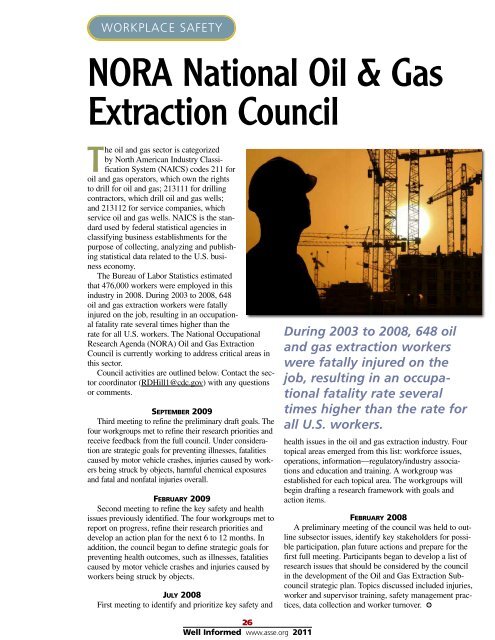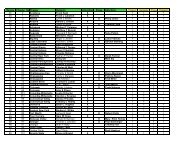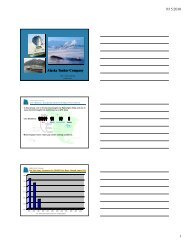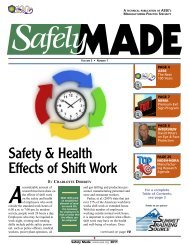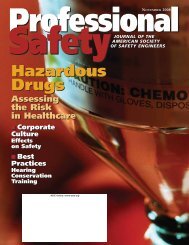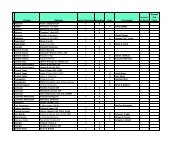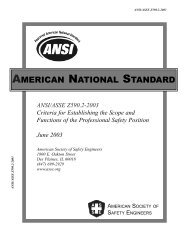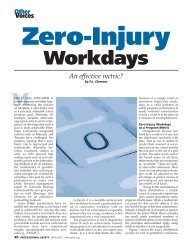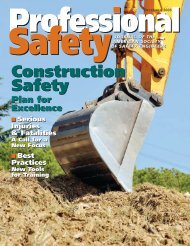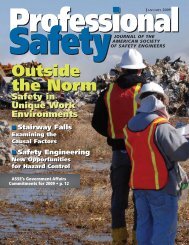OSHA's Flame-Resistant Clothing Policy - ASSE Members
OSHA's Flame-Resistant Clothing Policy - ASSE Members
OSHA's Flame-Resistant Clothing Policy - ASSE Members
Create successful ePaper yourself
Turn your PDF publications into a flip-book with our unique Google optimized e-Paper software.
WORKPLACE SAFETYNORA National Oil & GasExtraction CouncilThe oil and gas sector is categorizedby North American Industry ClassificationSystem (NAICS) codes 211 foroil and gas operators, which own the rightsto drill for oil and gas; 213111 for drillingcontractors, which drill oil and gas wells;and 213112 for service companies, whichservice oil and gas wells. NAICS is the standardused by federal statistical agencies inclassifying business establishments for thepurpose of collecting, analyzing and publishingstatistical data related to the U.S. businesseconomy.The Bureau of Labor Statistics estimatedthat 476,000 workers were employed in thisindustry in 2008. During 2003 to 2008, 648oil and gas extraction workers were fatallyinjured on the job, resulting in an occupationalfatality rate several times higher than therate for all U.S. workers. The National OccupationalResearch Agenda (NORA) Oil and Gas ExtractionCouncil is currently working to address critical areas inthis sector.Council activities are outlined below. Contact the sectorcoordinator (RDHill1@cdc.gov) with any questionsor comments.SEPTEMBER 2009Third meeting to refine the preliminary draft goals. Thefour workgroups met to refine their research priorities andreceive feedback from the full council. Under considerationare strategic goals for preventing illnesses, fatalitiescaused by motor vehicle crashes, injuries caused by workersbeing struck by objects, harmful chemical exposuresand fatal and nonfatal injuries overall.FEBRUARY 2009Second meeting to refine the key safety and healthissues previously identified. The four workgroups met toreport on progress, refine their research priorities anddevelop an action plan for the next 6 to 12 months. Inaddition, the council began to define strategic goals forpreventing health outcomes, such as illnesses, fatalitiescaused by motor vehicle crashes and injuries caused byworkers being struck by objects.JULY 2008First meeting to identify and prioritize key safety andDuring 2003 to 2008, 648 oiland gas extraction workerswere fatally injured on thejob, resulting in an occupationalfatality rate severaltimes higher than the rate forall U.S. workers.health issues in the oil and gas extraction industry. Fourtopical areas emerged from this list: workforce issues,operations, information—regulatory/industry associationsand education and training. A workgroup wasestablished for each topical area. The workgroups willbegin drafting a research framework with goals andaction items.FEBRUARY 2008A preliminary meeting of the council was held to outlinesubsector issues, identify key stakeholders for possibleparticipation, plan future actions and prepare for thefirst full meeting. Participants began to develop a list ofresearch issues that should be considered by the councilin the development of the Oil and Gas Extraction Subcouncilstrategic plan. Topics discussed included injuries,worker and supervisor training, safety management practices,data collection and worker turnover. 26Well Informed www.asse.org 2011


